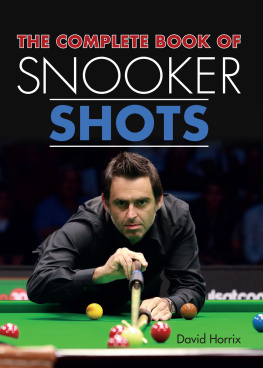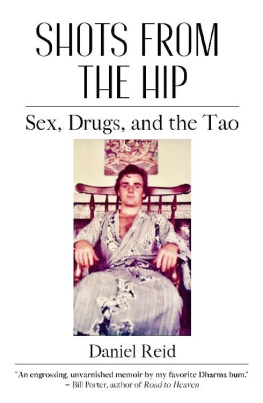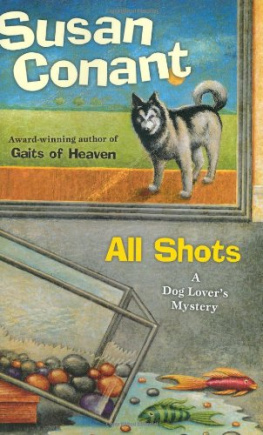Finally! Someone has had the cleverness, initiative, and imagination to set down on paper a film language that has been passed down and amalgamated only by word of mouth since the days of Mlis and D. W. Griffith. Like Dr. Johnsons Dictionary of the English Language, Christopher Kenworthys Master Shots series seeks to make tangible and permanent what otherwise might be gone with the wind.
John Badham, Director, Saturday Night Fever, WarGames, Short Circuit; Author, Ill Be in My Trailer and John Badham on Directing; Professor of Media Arts, The Dodge School, Chapman University
Ive directed five features and a ton of TV and I wish to God Id had this book at the beginning of my career. Its an unbelievably comprehensive resource for filmmakers. I cant wait to go back and look at Volumes 1 and 2.
Tom Lazarus, Screenwriter, Director, Educator, Author, The Last Word
You can take ten years to figure out lensing or you can read this book and use that ten years to create your art instead. Your choice.
Tony Levelle, Author, Digital Video Secrets; Co-author, Producing with Passion
The latest installment in Kenworthys Master Shots series lives up to its predecessors and then some, offering up even more exciting ways to frame and follow your action. All three Master Shots books belong on the bookshelf of every serious filmmaker.
Troy DeVolld, Author, Reality TV
Christopher Kenworthys Master Shots Vol 3 is essential reading for both directors and cameramen, and helpful to anyone who works in or studies the art of filmmaking. The book is clear and instructive with great visual samples.
Catherine Ann Jones, Author, The Way of Story and Heal Your Self with Writing; Screenwriter and TV Writer, Touched by an Angel and The Christmas Wife
Christopher Kenworthy teaches readers the nouns and verbs and participles and definite articles of the language of cinema, equipping them to tell stories on the screen with the power that flows from fluency. Kenworthy understands the interplay between image, character, story, and emotion. He writes so that his readers will understand, too.
Chris Riley, Author, Hollywood Standard, 2nd Edition
Master Shots Vol 3 continues this ultimate reference-book series that is a must-have guide for directors and cinematographers on how to find interesting ways to tell your story visually.
Marx H. Pyle, Producer/Co-host, GenreTainment; Director/Creator, Reality On Demand
A fascinating look at amazingly simple ways to use the camera, making this an essential read for anyone looking to hone the craft of visual storytelling.
Erin Corrado, www.onemoviefiveviews.com
Master Shots Vol 3 offers fabulous insight into the purpose behind each shot. Im so thankful for this book its my new secret weapon!
Trevor Mayes, Screenwriter/Director
CHRISTOPHER KENWORTHY
MASTER SHOTS VOL 3
THE DIRECTORS VISION 100 Setups, Scenes and Moves for Your Breakthrough Movie


Published by Michael Wiese Productions
12400 Ventura Blvd. #1111
Studio City, CA 91604
(818) 379-8799, (818) 986-3408 (FAX)
mw@mwp.com
www.mwp.com
Cover design by Johnny Ink. www.johnnyink.com
Edited by Gary Sunshine
Interior design by William Morosi
Printed by McNaughton & Gunn
Manufactured in the United States of America
Copyright 2013 by Christopher Kenworthy
All rights reserved. No part of this book may be reproduced in any form or by any means without permission in writing from the author, except for the inclusion of brief quotations in a review.
Library of Congress Cataloging-in-Publication Data
Kenworthy, Christopher.
Master shots. Volume 3, The directors vision : 100 setups, scenes, and moves for your breakthrough movie / Christopher Kenworthy.
pages cm
ISBN 978-1-61593-154-5
1. Cinematography. I. Title. II. Title: Directors vision.
TR850.K4633 2013
777.8--dc23
2013015076
Printed on Recycled Stock
CONTENTS
INTRODUCTION
Nothing is more important than learning to see like a director, and readers tell me that the Master Shots books give them that ability. They learn to shoot like pros. They learn to make a low-budget shot look like it cost a fortune. They find ways to be inventive, when the clock is ticking.
My readers have asked for more. I received many emails asking for a third book, one that goes deeper, showing more than a collection of moves. People didnt want me to show another 100 cool shots. They wanted to learn how to develop a directors vision.
The best movies need great acting, a fabulous script, and an adaptable crew. They also need great shots. Without creative camera work, youre letting down everybody else, watering down the story and wasting the opportunity to make a great film.
If you shoot a great actor in an average way, the result is disappointing. If you shoot an exquisite set without innovation, the moneys been thrown away. If you shoot a wonderful story with traditional setups, the result will be boring. If you care about your film, you should care about every shot. Masterful shots are your gift to the audience.
Your job is not to look cool by creating exciting camera setups, nor is your job to shoot basic coverage and hope the editor can save your movie. Your job is to design shots that reveal story, expose emotion, explore character, and capture the unique feeling of your film. At the same time, you should stamp your film with your own style. This book can help you do that.
Almost every day I get emails from people who are using the Master Shots books. I am told by experienced directors, teachers, film school students, and commercial videomakers that these are the books they take to set with them. These are the books they use to solve problems, and the books they have in hand when they first sit down to imagine how theyre going to shoot their film.
Writers tell me they have gained a better understanding of how scenes work, having read my books, and they can now write in ways that make scripts appealing to directors. They understand the flow of movement and emotion that is the key to the Master Shots approach.
Actors and drama teachers tell me the Master Shots books are one of the best ways for performers to get to grips with the needs of the camera. With the tools in these books explained to them, actors better understand how directors see the world, and know what they are trying to achieve.
Master Shots Vol 1 is the best introduction to powerful camera moves that can be applied to your movie. Its a crash course in camera work that can be applied to just about any scene. Its used by absolute beginners, along with directors who have been working in Hollywood for decades.
Master Shots Vol 2 shows how to solve the directors greatest challenge: keeping a film visually interesting when then action stops and the talking begins. I get many emails from directors telling me that their films have been brought to life by seeing the importance of capturing dialogue well. Master Shots Vol 2 is for directors who are serious about getting to the heart of their films. Its also the most popular book with actors, because it shows how to make their most important dialogue scenes shine.
Next page







